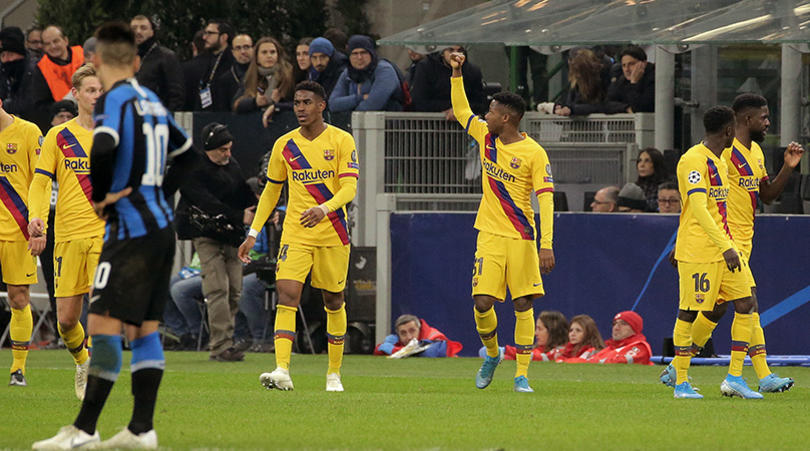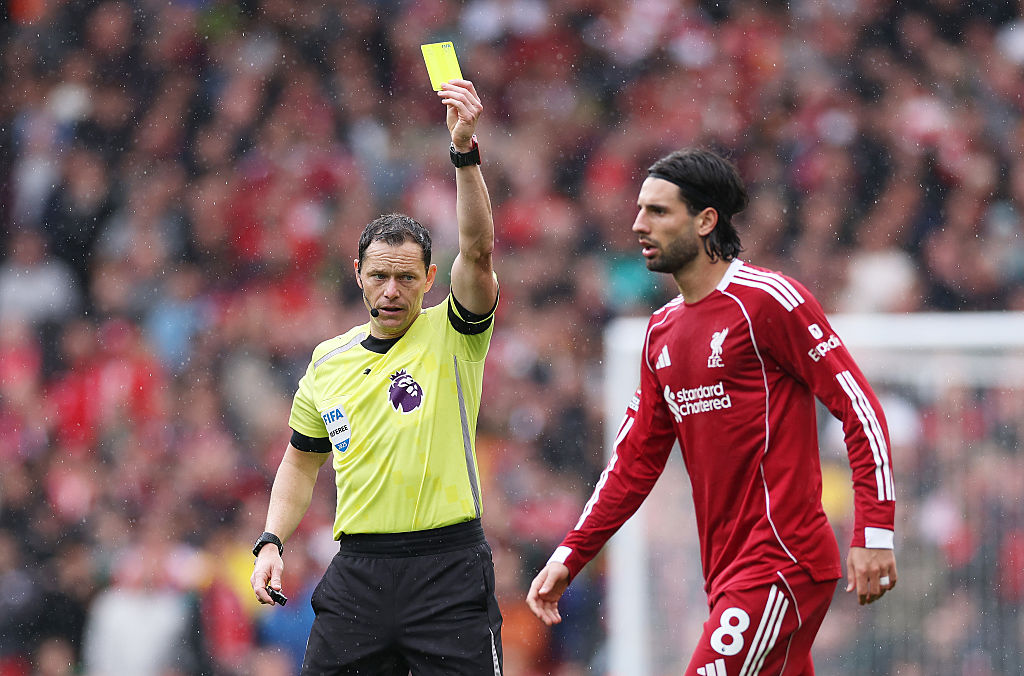Champions League last-16 draw probabilities: Why Chelsea are more likely to get Barcelona – and what fates await Liverpool, Man City and Tottenham
The way Monday's UEFA draw works means we already have an idea of who might be playing who in the first Champions League knockout round. Prepare to get nerdy...
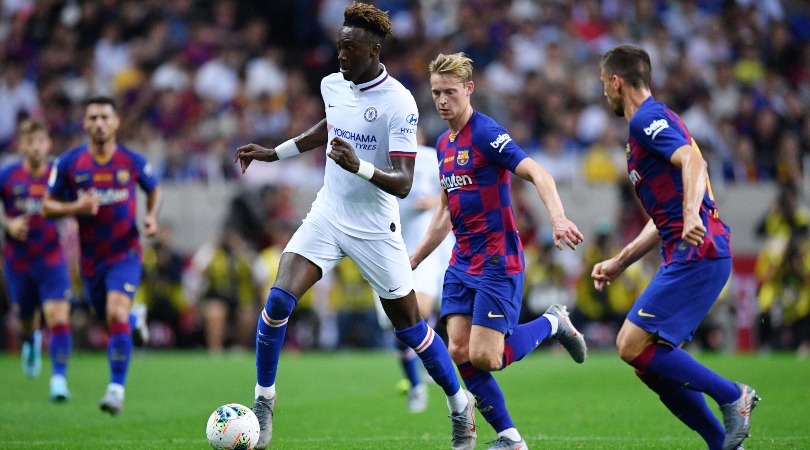
Julien Guyon is a French mathematician and football fan. He is a quantitative analyst, and adjunct professor in the Department of Mathematics at Columbia University and at the Courant Institute of Mathematical Sciences, New York University. More probability tables are available on the author's Twitter account and website
The last 16 of this season's Champions League will be drawn on Monday, December 16 – but we can already work out which fixtures are more or less likely than others.
The draw probabilities can be quite surprising. For example, Liverpool and Manchester City have a 22.4% chance of drawing Atletico Madrid, but only a 17% chance of drawing Lyon.
For Tottenham, the most likely opponent is Valencia (22.6%), while the least likely opponents are PSG and Leipzig (17.3%). Of all possible matchups, Barcelona vs Chelsea is the most likely (23.3%), like two years ago (at the time, that probability exceeded 40%); Bayern Munich vs Lyon is the least likely (14.3%). The following table provides the draw probabilities for all 16 teams.
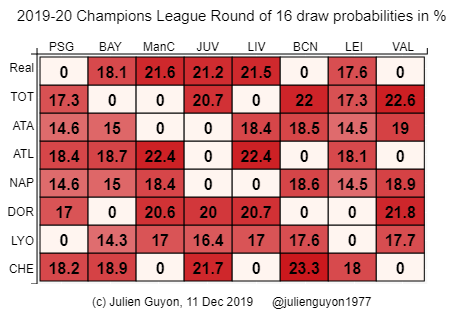
All English teams have only five possible opponents. This is due to the constraints that UEFA puts on the draw: group winners must be paired with group runners-up; moreover, a team cannot be drawn against another team from the same federation, or against a team that it met during the group stage.
England's four representatives all advanced to the last 16. Manchester City and Liverpool won their groups; Tottenham and Chelsea finished second in theirs. As a consequence, all English teams are only allowed to meet five opponents. For instance, Liverpool can only get the five runners-up that are not English or Napoli (who finished second in Liverpool’s group): that's Real Madrid, Atalanta, Atletico Madrid, Borussia Dortmund and Lyon.
Why the probabilities aren’t what you think
The best features, fun and footballing quizzes, straight to your inbox every week.
You might think that Liverpool have a 20% chance of drawing any of those five teams. That would be the case if the Reds received a particular treatment at the beginning of the draw: one of five balls (Real, Atalanta, Atletico, Dortmund, Lyon) would be picked from a bowl to decide their opponent. But it's not how the draw works.
You may also think that, to compute the probability that two teams meet, you should first list all the admissible outcomes of the draw – that is, those which satisfy all the constraints (this year there are exactly 2,002 of them) – and then compute the proportion of those 2,002 outcomes for which A and B are paired.
Among the 2,002 possible outcomes of the draw, there are exactly 453 outcomes in which Liverpool are paired with Atletico, corresponding to a proportion of 22.6%, while there are only 341 outcomes in which Liverpool can be paired with Lyon. The reason? Because Atletico can only meet five opponents (Barcelona, Valencia, and Juventus are forbidden), while Lyon can meet six.
Many people mistakenly report 22.6% as the probability of Liverpool vs Atletico. It would be correct if the draw consisted of putting 2,002 balls – one for each admissible outcome – in a (very big) bowl and picking randomly one of them to decide the whole draw. But this isn't feasible (er, thankfully): the draw doesn't work this way, so the probability of Liverpool-Atletico is NOT 22.6%.
The very simple process
To compute the true draw probability, you must examine the official procedure used by UEFA.
A bowl containing eight balls, one per runner-up, is sequentially emptied. Each time a runner-up is drawn, a computer lists the admissible opponents for that team.
This can be more complicated than you think. Imagine, for instance, that at the end of the draw, the last two remaining runners-up are Tottenham and Chelsea – and the last two available group winners are Valencia and Barcelona. If Spurs get picked, then you’d think they could go with Valencia or Barcelona.
But if they're paired with Barça, that would mean the last matchup would be Chelsea vs Valencia – but that's forbidden, since those teams met during the group stage. In this case, only Valencia would be listed as an admissible opponent for Tottenham, and Chelsea would (again) meet Barcelona. When the list is displayed, one of the admissible opponents is drawn randomly.
I computed the draw probabilities by simulating it one million times, according to the official UEFA draw procedure. It's also possible to calculate the exact probabilities on a computer. Both methods give the same results, up to the (very small) sampling error of the simulation method. The draw procedure has an impact on the probabilities: Liverpool vs Atletico is less likely than it should be (22.4% vs 22.6%), whereas Liverpool vs Atalanta is more likely than it should be (18.4% vs 17.7%). By 'should be', I mean if all of the 2,002 admissible outcomes of the draw were equally likely.
To illustrate the impact of the procedure on probabilities, I also computed what the draw probabilities would be if – instead of emptying the pot of runners-up – UEFA emptied the pot of group winners. The probabilities would be slightly different.
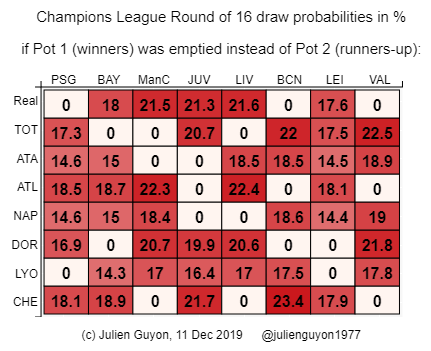
Finally, I also computed what the draw probabilities would have been if Chelsea had won their group ahead of Valencia. Both teams got 11 points in Group H; Valencia won out to favourable head-to-head results.
If UEFA didn't use head-to-head results as tiebreakers, Chelsea would have won their group with the same goal difference as Valencia, but more goals scored. As you can see, the probabilities would have been different – not only for those teams, but for all teams: Barcelona vs Tottenham would have been very likely, with a probability exceeding 32%. One head-to-head result can have a huge impact on the rest of the competition.
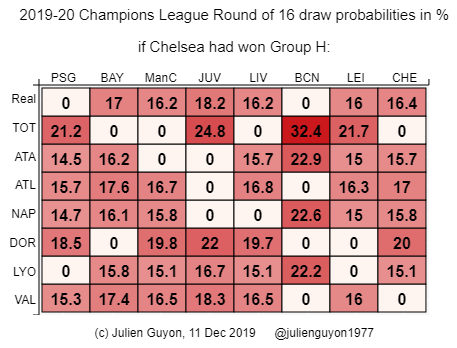
Remember, though, as a concluding note: the fact that Liverpool and Manchester City have a combined 44.8% chance of drawing Atletico Madrid also means there is a greater chance (55.2%) that none of them draw the Rojiblancos. Now that's maths...
While you're here, why not take advantage of our brilliant subscribers' offer? Get the world's greatest football magazine for £9.50 every quarter (that's £2.90 an issue)
NOW READ…
LONG READ It's not the economy, stupid – how football cost Labour a general election
QUIZ Can you name the 50 best teams ever in the European Cup/Champions League?
GUIDE Premier League live stream best VPN: how to watch every game from anywhere in the world
